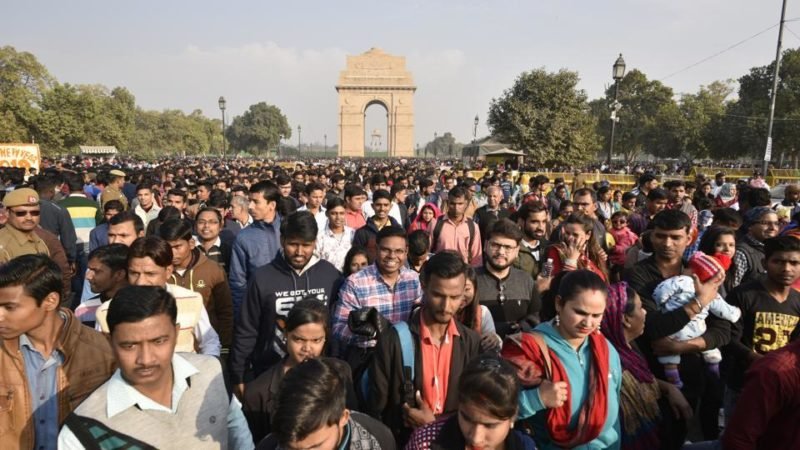Overcoming the Challenges: World Population Prospects 2019 Report

“More than half of the projected increase in the global population up to 2050 will be concentrated in just nine countries: The Democratic Republic of the Congo, Egypt, Ethiopia, India, Indonesia, Nigeria, Pakistan, the United Republic of Tanzania, and the United States of America.
India is projected to surpass China as the world’s most populous country around 2027.” [1]
While India’s population grows, it also grows to be relatively one of the youngest countries in the world, especially compared to other populated states. While that is an asset, being a young nation also means that the majority of the population is a reproductive population.
To understand the overwhelming population growth in India, and what it means for the economy and development of the country, there needs to be an understanding that this growth is going to be concentrated, and highly unequal. Population growth happens in developing countries for many shared reasons and results in population growth significantly more in rural, poverty and illiteracy-driven areas than in urban areas or cities. This can happen for numerous reasons. The subdued and often overlooked areas that result in unhealthy population growth come from illegal child marriages, poverty, lack of education and patriarchal cultural norms that emphasize on the necessity of having a boy child. Poverty often incentivizes families, such as that of farmers, to have more children in order to cover up costs of additional labour that they might have to pay for. Like mentioned by V. A. Pai Panandiker and P. K. Umashankar in “Fertility Control and Politics in India” under the Population and Development review – “the need to limit family size to improve one’s own lot and that of one’s children is not appreciated in a situation where ‘sheer survival’ is the main concern.”[2]
These reasons also shape the challenges that India will face with its growing people, and also the benefits that population growth can bring out. Needless to say, youth demographic is a country’s biggest economic asset.
According to the World Population Prospects 2019 report by the United Nations (UN), by 2050 India will have a growing population more than any other country, but also will consist of a large number of young people. It is predicted that the growth in percentage for people aged 65 and above will more between 10 to 15 %, which is a better statistic than India’s South Asian neighbours Bangladesh and Sri Lanka which will are predicted to have a growth of more than 15% in the same age group.[3] This essentially means that there is a huge scope in the upcoming years for economic growth and technological development within India. In China, however, the overall population is projected to shrink by 31.4 million, or 2.2 per cent.[4] The current dynamics, however, poses challenges that need to be dealt with in a rather effective and quick manner.
Growing populations indicate development in important areas such as that of reducing mortality and shows that there is more access to sexual and reproductive health care.[5] It also shows that fertility rates might be rather higher than sustainable ideals. Countries, where fertility levels remain high, should prepare to meet the needs of growing numbers of children and young people.[6] This is also relevant to India where there seems to be no compulsory law for family planning as such, which exposes the nation to overwhelming population growth with no control. To retrospect, a bill was proposed by Prahalad Singh Patel a few years ago for the implementation of a two-child policy in India which however did not even get to a vote.[7] As Mr Patel rightly pointed out – there was a growing population on a small land. The country will soon run out of adequate resources to provide to everybody. “The Indian government, however, does not have any plans to implement a two-child policy since it is a signatory to the International Conference on Population and Development declaration. Signed in 1994, the declaration advocates free speech and honours the reproductive rights of couples to decide freely and responsibly the number and spacing of children”, a report in the CNN pointed out. India currently rests on voluntary access to family planning with no compulsion.
Another issue that relates to the idea of family planning is that of awareness of the usage of contraceptives and the inclusion of sex education in curriculums that provide students with the means of understanding the importance of using contraceptives and further of family planning when it essentially might be needed.
It has been pointed out in the World Prospects Report 2019 again, that “an accelerated expansion in access to family planning information and services could result in a more rapid fertility decline and a smaller global population in the future.” [8]
The next and perhaps the toughest challenge for India will be that of attaining the Sustainable Development Goals (SDGs) and keeping up with the balance as the population grows. As the country progresses towards achieving these goals, it also needs to keep up with the rising number of people. For example, SDG 4 which focuses on education, is one of the goals that need to be dealt with immediately. Growing populations means increasing facilities and resources that give access to education. Similar is the case with environmental issues, 9 out of the 10 most polluted cities are in India. Growing population indicates higher rates of pollution unless already controlled and dealt with before the problem escalates. These problems become more prevalent because of where this growth is concentrated. In areas with low literacy and high poverty, it is harder to achieve goals if people there are themselves not aware of the problems they might face in the longer run. To achieve SDGs, two-way cooperation between the people and the state needs to be effective. Such a condition might be hard to achieve with a huge number of illiterate persons, that grows by the day.
The concentration of population growth and achieving the SDGs might prove to be a tough challenge, but population growth also means the scope for economic and technological development. If youth demographics are planned well, the growing population can turn out to be an asset. This requires keeping up to date with the technology and skills required for professional jobs by providing regular vocational training. With frequent significant changes in technology, vocational and other training to enhance the skills of young professionals is a challenge to India.[9] For example, schemes like the ones initiated by the Ministry of Skills Development and Entrepreneurship in October 2018 where there was a task force created to enable the closing of the skills gap in India, are highly beneficial.
The next step up the ladder lies by not restricting the classification of cities in terms of how urban they actually are. Most towns and villages in India are more urban than they’re portrayed to be. An article in the Economic Times points out how not acknowledging towns as urban also encourage haphazard and chaotic development. It states that “as satellite data clearly shows, most cities extend well beyond their administrative limits, and dense, linear settlements spread out of those cities along transit corridors. This growth is unregulated and unplanned, marred by narrow roads, growing distance from major thoroughfares limited open space and haphazardly divided plots.” [10]
This issue is linked with that of infrastructure. If India wants to use her growing population as an asset, she needs to assure that this growth is provided with the resources to prove itself as assets. Infrastructure and town planning plays a huge role in containing the same. If cities expand due to the growing number of people, town planning must ensure it doesn’t cram up rural areas or vice versa, in the case of trying to develop rural areas. Proper transportation, sanitation, etc., need to be taken care of as well. The technological revolution that India can bring possibly cannot be brought by any other country due to the talent and cheap labour that thrives in the cities of the subcontinent. But in order to enable that a proper infrastructure needs proper interplay in keeping up with population growth.
Finally, the increased population also creates the risk of demands significantly surpassing supplies. This results in an increase in prices and unfavourable situations of poverty. Cases, where there isn’t enough food to feed the country, can lead to malnutrition, nation-wide health problems and perhaps other problems related to having a decent living condition.
What it means for India to be the most populous country can possibly show more negative determinants for the future than positive ones, but the pages can be turned otherwise. Proper planning in order to achieve goals already set need to be actively worked on by the government. Further awareness of family planning, a stricter implementation of the law for cases like child marriages, normalizing the usage of contraceptives, etc., can prove to be of significant help in maintaining unhealthy population growth. Provision of resources for keeping up with technological changes in the professional world, actively planning on balancing the SDG achievement goals with the growing population and creatively crafting economic policies for the best utilization of human resource can prove to highlight the importance of treating the growing population as an asset. It all depends on the efficiency at which the state succeeds in educating its citizens, and how competent enough it can prove to be whilst improving the efficiency of the country’s human resources.
[1] World Population Prospects 2019 (Highlights)
[2] V. A. Pai Panandiker and P. K. Umashankar, Fertility Control and Politics in India, Population and Development Review, Vol. 20 (Population Council)
[3] World Population Prospects 2019 (Highlights)
[4] ibid
[5] ibid
[6] ibid
[7] Swati Gupta, CNN, “India Two Child Policy Debate”: https://edition.cnn.com/2019/01/21/health/india-two-child-policy-debate/index.html
[8] World Population Prospects 2019 (Highlights)
[9] Mayuri Ghosh, WEF, “The Three Biggest Challenges for India’s Future”: https://www.weforum.org/agenda/2019/01/India-biggest-future-three-challenges-consumption/
[10] Reuben Abraham and Pritika Hingorani, Economic Times, “What our politicians are missing: India’s a land of cities not villages”: https://economictimes.indiatimes.com/news/politics-and-nation/what-our-politicians-are-missing-indias-a-land-of-cities-not-villages/articleshow/67498073.cms



















